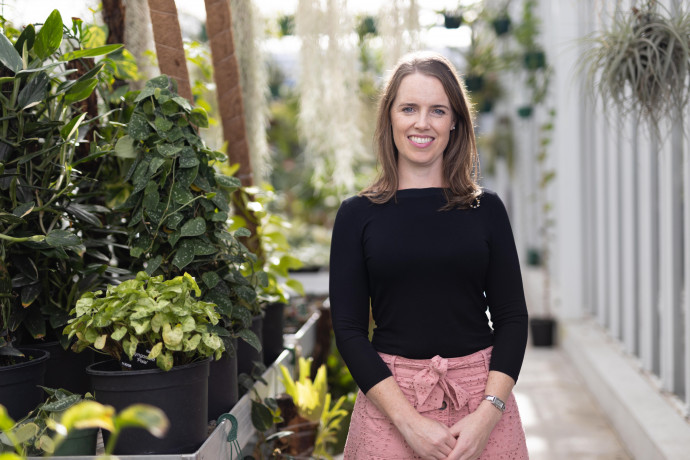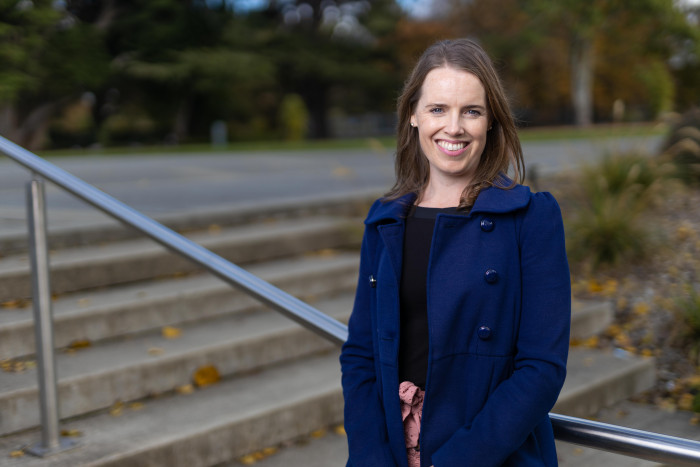Dr Shannon Davis

Shannon is a mother of three who balances motherhood with a passion for teaching; she is also a researcher who balances her career between two disciplines. Shannon's initial research focus centered around memorial sites, and while she still studies this, a teaching opportunity drove her to begin investigating urban greenspaces. Now she is a lecturer at Lincoln University who is determined to reconnect New Zealanders with their food by bringing production back to our backyards.
Q: What got you started into your research?
A: Initially I got into research through teaching. I had returned from working in the UK for a Landscape Architecture and Environmental Planning firm, and started a short-term tutoring role at the University. It was through the realisation of how much I enjoyed teaching, that I started my PhD.
While living and travelling through the UK and Europe I visited many memorial sites which sparked an interest in me about how we design sites of memory. This became the focus of my thesis, and saw me conduct field research in Cambodia and Rwanda exploring how Euro-western tourists experienced the genocide memoryscapes of these two countries.
I now work with post-graduate students who are interested in the same kinds of issues, and have in the last year for example, co-supervised two students looking at memorial landscapes in Colombia and Japan.
Q: What was your experience like visiting these memorial sites?
A: Researching sites that represent so much sorrow was a humbling experience. Researching the history of these tragedies, and the impact they had on so many people was often challenging. For example, one site I visited in Rwanda, the Murambi Genocide Memorial Centre has 1200 human victims preserved and displayed within the open classrooms of the former Technical School. Tourists are able to entre the classrooms and view the victims – men, women, children and infants.
With the growing interest in ‘dark tourism’ at the time however, an important question to ask was ‘what is the role of memorial design in shaping Euro-western tourists experience and interpretation of the these post-genocide memoryscapes?’ with more international tourists interested and visiting them, and ‘what experience were these foreign tourists having as a result of the way the memorials were designed?’
Q: What were your findings?
A: The findings showed that there is a universality in connection through human suffering. The often raw and explicit approach to memorial design in these contexts allowed for, and often promoted connection across ethnicity, race, gender and age, through the core factor of human suffering, and the fact that genocide has occurred all over the world, unbounded by geographic location.
The findings also showed that many of the sites included designed elements – both spatial and figurative – that specifically engaged the Euro-western tourist through our pre-understanding of Holocaust memorial design.
Q: What do you focus on now?
A: Although I still research and supervise post-grad students working in the areas of memory studies and memorial design, presently my main research focus has taken a bit of a turn, and this is also due really to my teaching commitments.
In 2017 when I returned from parental leave (I have three little boys), I was asked to develop a course that looked at the relationships between landscapes, food and people, and it was through doing that, that I now hold a research position (alongside my Lecturing position) within Lincoln University’s Centre of Excellence – Designing Future Productive Landscapes, where I am a Theme Leader investigating ‘Future Foodscapes for Health’.
Q: Can you elaborate on this work?
A: A basic essential of life, food, along with clean water, air and adequate shelter, should be considered an essential element of urban infrastructure. Today however, food production and access has become spatially disconnected as our ability to engage long global supply chains has grown. For the first time in history more humans are now living in urban areas than rural, and food production, historically an intrinsic part of our urban spatial structure, has been moved out of cities and their hinterlands, to the ‘rural zone’ – disconnected spatially from the places we now live.
Re-integrating food production within urban form is about reasserting the importance of having affordable and easy access to fresh, nutritious and healthy food within our everyday landscapes – and for the majority of people now, and certainly in Aotearoa, that everyday landscape is an urban one.
My research looks at how we can re-integrate food production and access into every zone along the rural-urban continuum, looking at spatial design models of agricultural retention, urban agriculture, and agricultural urbanism as approaches to implementation. The study investigates how these design models can be effectively integrated into both our existing urban form, and future growth of our cities, perhaps through the diversification of public greenspaces to include a productive layer, the creation of city CPUL’s (Continuous Productive Urban Landscapes), the requirement of new greenfield developments to include food production areas - ‘Agri-hoods’, or spatially connecting the numerous existing community gardens and urban farming projects into wider urban spatial planning.
Q: Did you always know you’d become a researcher?
A: The short answer is no I suppose, although as soon as the opportunity arose, I knew it was the right thing for me. I have always been the person who loved learning...and a career in research means that I get to be at the forefront of new knowledge, and for the spatial design disciplines, this also means being at the forefront of actual, grounded change to make the places we live better.

Q: Why do you do what you do?
A: I love the flexibility, freedom and growth that a research career supports. Research is exciting to me, and I get a huge sense of satisfaction out of it – out of the growth in understanding. And I love, by working at the university, being able to share this with students. Landscape Architectural research is particularly special I think because we can positively affect the way people live, through the places they dwell and through the spaces they experience – creating healthier, more diverse, vibrant and responsive landscapes. It is this idea that really drives my current research focus looking at how we can re-integrate food production and access back into the urban realm, where people and the environment benefit through local, connected and productive public spaces.
Q: What is it like balancing a research career with three children?
A: This is a really big issue for me, and something that I am always conscious of. I have three boys aged 9, 7 and 5, and I chose to take time off work when each of them was born, and then returned to work part-time, which is still currently my situation. Being a mum is really important to me, and being there for my kids in the morning, and after school is a priority. My husband runs his own company, so between us we make a great team in raising our boys. We are lucky our roles are flexible, and so one of us is always available to be with the boys, and we each make time available so that our careers can both thrive.
Q: Do you find that your research carries with you throughout your life? For instance, has it changed how you eat or travel?
A: Yes, absolutely. As my research and understanding has deepened, understanding the impacts that urban design has on the way people live, and the choices they make has really highlighted the importance of the way our cities are designed. Take our experience of lockdown for instance, and the number of families that ‘re-claimed’ the streets as places to walk and ride bikes. It was so exciting to see families outside together, in the city, using the streets and feeling safe to do so.
New Zealand cities have primarily been designed for car-orientated development, and so too, supermarkets are now our primary ‘local’ food supply. Imagine a city where walkable, multi-functional, urban greenspace infiltrated the urban landscape providing safe, healthy, and easy access to fresh food.
Q: What impact do you hope your teaching has on your students?
A: I want all my students to feel valued and encouraged. Creating a learning environment where students feel inspired to share their thoughts, listen to others, and grow their knowledge and skills is ultimately what I strive for in my teaching. A wide range of students from each faculty from the university come together in my courses, so creating an environment where students can discuss ideas from their own perspectives and angles is really important to me. It makes for a wonderful learning opportunity for everyone.
Q: What is one thing about doing what you do that inspires you to get out of bed in the morning?
A: I love the vibe of a university. There is always so much going on, and so many passionate and interesting people working together – both students and staff.
Shannon Davis
Dr
I want all my students to feel valued and encouraged. Creating a learning environment where students feel inspired to share their thoughts, listen to others, and grow their knowledge and skills is ultimately what I strive for in my teaching.
